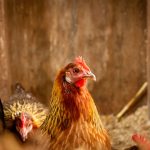Chickens, like all animals, have specific needs that must be met for optimal health and well-being, particularly during winter. These requirements include a warm, dry environment to protect against cold and damp conditions, access to fresh water, and a balanced diet to maintain energy levels and body heat. Adequate space for movement and natural behaviors is also essential, even in colder months.
Meeting these needs helps ensure chickens remain healthy and comfortable throughout winter. Chickens are susceptible to cold-related health issues such as frostbite and hypothermia if not properly cared for during winter. Providing a sheltered environment that protects against wind, rain, and snow is crucial.
Constant access to fresh water is necessary to prevent dehydration, which can lead to health problems and reduced egg production. A balanced diet with sufficient energy content is vital for chickens to maintain warmth during colder periods. Understanding and addressing these fundamental requirements enables chicken owners to effectively prepare their flocks for winter challenges.
Table of Contents
- 1 Providing Adequate Shelter for Chickens
- 2 Insulating the Coop
- 3 Using Heat Lamps or Heaters
- 4 Providing Warm Bedding
- 5 Adjusting the Diet for Winter
- 6 Monitoring and Maintaining the Coop Temperature
- 7 FAQs
- 7.1 What are the best ways to keep backyard chickens warm in winter?
- 7.2 How can I insulate my chicken coop for winter?
- 7.3 Is it safe to use heat lamps or heated pads for backyard chickens in winter?
- 7.4 What temperature is too cold for backyard chickens?
- 7.5 How can I ensure good ventilation in the chicken coop during winter?
Key Takeaways
- Chickens need extra care in winter to stay healthy and comfortable
- Adequate shelter is essential to protect chickens from harsh weather conditions
- Insulating the coop helps to maintain a comfortable temperature for chickens
- Heat lamps or heaters can be used to provide additional warmth in the coop
- Warm bedding such as straw or wood shavings helps to keep chickens cozy in winter
Providing Adequate Shelter for Chickens
Protection from the Elements
One of the most important aspects of caring for chickens in winter is providing them with adequate shelter. This shelter should protect them from the elements, including wind, rain, and snow, while also allowing for proper ventilation to prevent moisture buildup. A well-constructed coop with a solid roof and walls will provide the necessary protection from the elements, while also providing a safe and secure environment for your flock.
Space and Comfort
Additionally, it’s important to ensure that the coop is large enough to accommodate all of your chickens comfortably, with enough space for them to move around and engage in natural behaviors. In addition to a well-constructed coop, it’s important to provide your chickens with access to a covered outdoor area where they can stretch their legs and get some fresh air, even during the winter months.
Designing the Perfect Shelter
This outdoor area should be protected from wind and precipitation, while still allowing for natural light and ventilation. By providing your chickens with a well-designed shelter that meets their needs for protection and space, you can help them stay healthy and comfortable throughout the winter.
Insulating the Coop

Insulating the coop is an effective way to help keep your chickens warm during the winter months. Proper insulation can help regulate the temperature inside the coop, keeping it warmer in cold weather and cooler in hot weather. There are several ways to insulate a coop, including adding insulation material to the walls, ceiling, and floor, as well as sealing any drafts or gaps that could let cold air in.
It’s important to use materials that are safe for chickens and won’t pose a fire hazard, such as straw, hay, or foam board insulation. In addition to insulating the coop itself, it’s important to pay attention to the coop’s windows and doors. Adding storm windows or plastic sheeting over windows can help keep cold air out, while still allowing for natural light.
Similarly, adding weather stripping or draft guards to doors can help prevent drafts from entering the coop. By properly insulating the coop and sealing any drafts, you can help maintain a comfortable and stable environment for your chickens throughout the winter.
Using Heat Lamps or Heaters
In some cases, especially in extremely cold climates, it may be necessary to use heat lamps or heaters to help keep your chickens warm during the winter. Heat lamps can be hung in the coop to provide additional warmth, while heaters can be used to regulate the temperature inside the coop. It’s important to use these heating devices with caution, as they can pose a fire hazard if not used properly.
Additionally, it’s important to monitor the temperature inside the coop regularly to ensure that it stays within a safe range for your chickens. When using heat lamps or heaters, it’s important to place them in a safe location where they won’t come into contact with flammable materials or pose a risk of injury to your chickens. It’s also important to use heating devices that are specifically designed for use in coops or barns, as they are designed to be safe for use around animals.
By using heat lamps or heaters responsibly and monitoring the temperature inside the coop, you can help ensure that your chickens stay warm and comfortable throughout the winter.
Providing Warm Bedding
Providing warm bedding is another important aspect of caring for chickens in winter. Bedding helps insulate the coop floor, keeping it warmer and drier for your chickens. Good bedding materials include straw, hay, wood shavings, or shredded paper.
It’s important to regularly clean and replace bedding to prevent moisture buildup and keep it dry and comfortable for your chickens. In addition to providing warm bedding inside the coop, it’s also important to provide your chickens with a dry area outside where they can dust bathe and sunbathe. This helps them stay clean and healthy during the winter months.
By providing warm bedding and a dry outdoor area for your chickens, you can help them stay comfortable and healthy throughout the winter.
Adjusting the Diet for Winter

Boosting Energy Intake
Increasing their daily feed rations or providing high-energy treats such as cracked corn or black oil sunflower seeds can help achieve this. This extra energy will enable your chickens to maintain their body heat and stay healthy.
Hydration is Key
It’s crucial to ensure that your chickens have access to fresh water at all times. Dehydration can lead to health issues and decreased egg production, making it vital to monitor their water intake during the winter.
A Balanced Diet for Optimal Health
In addition to providing extra energy, it’s essential to offer a balanced diet that includes all the necessary nutrients for your chickens’ overall health. A good quality layer feed that provides essential vitamins and minerals, along with access to grit and oyster shell for calcium and digestion, is vital. By adjusting your chickens’ diet to meet their increased energy needs during the winter, you can help them stay healthy and thrive.
Monitoring and Maintaining the Coop Temperature
Finally, it’s important to regularly monitor and maintain the temperature inside the coop throughout the winter. This can be done using a thermometer placed inside the coop where it can be easily read. The ideal temperature for chickens in winter is between 45-65 degrees Fahrenheit (7-18 degrees Celsius).
It’s important to regularly check the temperature inside the coop and make adjustments as needed to ensure that it stays within this range. In addition to monitoring the temperature inside the coop, it’s also important to regularly check for drafts or other sources of cold air that could affect the temperature inside the coop. Sealing any drafts or gaps can help maintain a stable temperature inside the coop and keep your chickens warm and comfortable throughout the winter.
By regularly monitoring and maintaining the temperature inside the coop, you can ensure that your chickens have a safe and comfortable environment throughout the winter months. In conclusion, caring for chickens in winter requires attention to their specific needs for warmth, shelter, food, and water. By understanding these needs and taking appropriate measures such as providing adequate shelter, insulating the coop, using heat lamps or heaters responsibly, providing warm bedding, adjusting their diet for winter, and monitoring and maintaining the coop temperature, you can help ensure that your flock stays healthy and comfortable throughout the colder months.
With proper care and attention, your chickens can thrive even in the coldest of winters.
If you’re looking for tips on keeping backyard chickens warm in winter, you might also be interested in learning how to convert a shed into a chicken coop. This article provides helpful information on transforming an existing structure into a cozy and functional space for your feathered friends.
FAQs
What are the best ways to keep backyard chickens warm in winter?
Some of the best ways to keep backyard chickens warm in winter include providing a well-insulated coop, using heat lamps or heated pads, and ensuring good ventilation while avoiding drafts.
How can I insulate my chicken coop for winter?
You can insulate your chicken coop for winter by adding extra bedding, sealing any drafts, and using insulating materials such as foam board or straw bales. It’s important to ensure that the coop remains well-ventilated despite the insulation.
Is it safe to use heat lamps or heated pads for backyard chickens in winter?
When used properly, heat lamps or heated pads can be safe for backyard chickens in winter. It’s important to follow manufacturer’s instructions, keep the heat source away from flammable materials, and monitor the coop for any signs of overheating.
What temperature is too cold for backyard chickens?
Backyard chickens can generally tolerate cold temperatures as long as they have a dry and draft-free coop with adequate insulation. However, temperatures below freezing (32°F or 0°C) can be particularly challenging, especially if there is high humidity or strong winds.
How can I ensure good ventilation in the chicken coop during winter?
You can ensure good ventilation in the chicken coop during winter by providing adjustable vents, using a ridge vent, and keeping the coop clean to prevent moisture buildup. Good ventilation helps to remove excess moisture and ammonia from the coop while preventing drafts.
Meet Walter, the feathered-friend fanatic of Florida! Nestled in the sunshine state, Walter struts through life with his feathered companions, clucking his way to happiness. With a coop that’s fancier than a five-star hotel, he’s the Don Juan of the chicken world. When he’s not teaching his hens to do the cha-cha, you’ll find him in a heated debate with his prized rooster, Sir Clucks-a-Lot. Walter’s poultry passion is no yolk; he’s the sunny-side-up guy you never knew you needed in your flock of friends!








